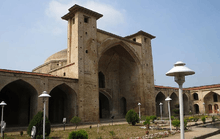Farahabad, Mazandaran

Farahabad (English: "abode of joy") was a palace and city built by Shah Abbas I in Mazandaran, Iran. It was built on a site formerly known as Tahan[1] and linked to the town of Sari, 17 miles (27 km) away, by a stone causeway. The shah used the city as his winter capital, and he died there in 1629.
Shah Abbas was fond of the province of Mazandaran, the birthplace of his mother Khayr al-Nisa Begum. Work began on the palace in 1611–12. Situated on top of a hill with a view of the sea and the Elburz Mountains, it was decorated with murals by Reza Abbasi and goldwork by a German craftsman, and surrounded by gardens in the Persian style.
The city grew around the palace. In 1618, the Italian traveller Pietro della Valle visited Farahabad and compared the length of the walls to that of Rome or Constantinople. The population was made up of peoples resettled from other regions of Abbas' empire. According to della Valle (who had spoken to the shah himself) they included 40,000 Armenian families, 12,000 Georgian families, 7,000 Jewish families and 25,000 Muslim families from the Caucasus. The Jewish merchants were given privileges similar to the Armenians in New Julfa, Isfahan.[2] Abbas hoped they would help promote Iranian commerce, especially the silk and wine trades.
Abbas' successors neglected Farahabad. The climate in the summer was unhealthy and malarial. A large numbers of the immigrant residents died of epidemics, particularly malaria. Many Armenians and Georgians abandoned the city and returned to their native lands. In 1668 the Russian rebel cossacks led by Stepan Razin sacked Farahabad. Today little remains of the town. The main remains today are the restored main mosque, built to a similar ground plan like the Masjed-e Shah in Isfahan, the ruins of the royal palace and parts of a bridge over the Tajandrud river which belonged to the royal road connecting Isfahan with the palaces of the Caspian region.[3]
Farahabad was also the name of a palace and gardens built by Shah Sultan Husayn near Isfahan.
References
- ↑ The name of the village might rather have been "Tajan". The entry seems to rely on the quoted book by Savory who gives "Tahan" as the original name. As the local river up to this date is called "Tajan", Savory may have misread the name تجن as "تحن"
- ↑ cf. Aptin Khanbaghi: The Fire, the Star and the Cross: Minority Religions in Medieval and Early Modern Iran, p 107 f.; 2006; ISBN 1845110560 - ISBN 978-1845110567
- ↑ cf the entry "Farahabad" in Encyclopedia Iranica http://www.iranicaonline.org/articles/farahabad
- H. Nahavandi, Y. Bomati, Shah Abbas, empereur de Perse (1587-1629) (Perrin, Paris, 1998) pp. 222–226
- Roger Savory Iran under the Safavids (Cambridge University Press, 2007 reissue) pp. 96–100
| Wikimedia Commons has media related to Farah Abad, Sari. |
Coordinates: 30°26′N 56°53′E / 30.433°N 56.883°E